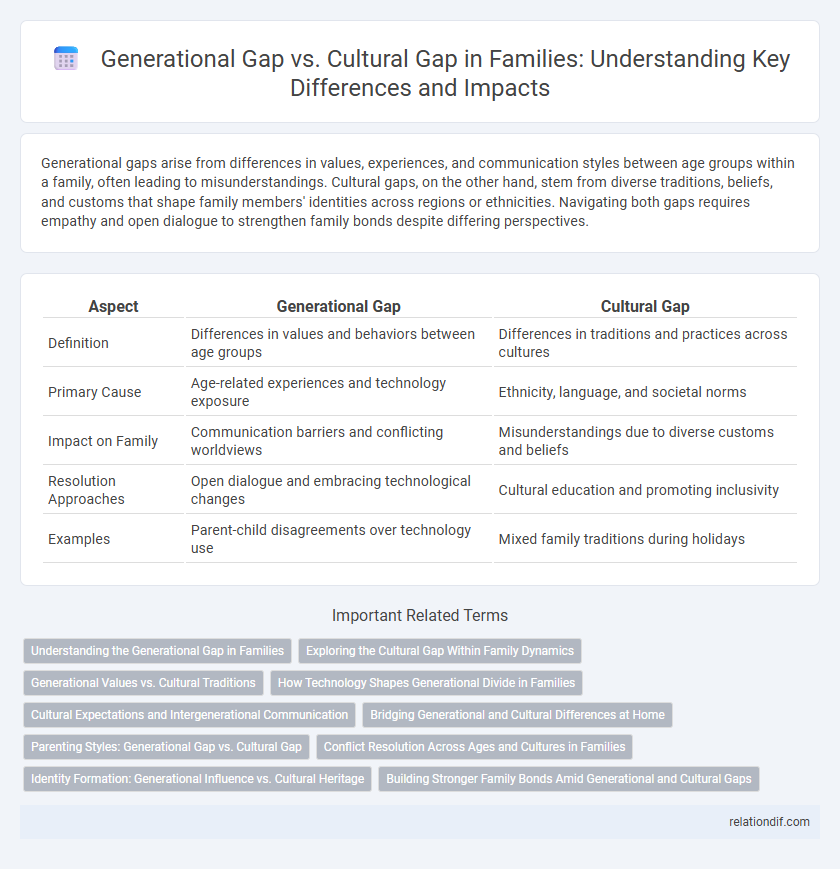Generational gaps arise from differences in values, experiences, and communication styles between age groups within a family, often leading to misunderstandings. Cultural gaps, on the other hand, stem from diverse traditions, beliefs, and customs that shape family members' identities across regions or ethnicities. Navigating both gaps requires empathy and open dialogue to strengthen family bonds despite differing perspectives.
Table of Comparison
| Aspect | Generational Gap | Cultural Gap |
|---|---|---|
| Definition | Differences in values and behaviors between age groups | Differences in traditions and practices across cultures |
| Primary Cause | Age-related experiences and technology exposure | Ethnicity, language, and societal norms |
| Impact on Family | Communication barriers and conflicting worldviews | Misunderstandings due to diverse customs and beliefs |
| Resolution Approaches | Open dialogue and embracing technological changes | Cultural education and promoting inclusivity |
| Examples | Parent-child disagreements over technology use | Mixed family traditions during holidays |
Understanding the Generational Gap in Families
Understanding the generational gap in families involves recognizing differences in values, communication styles, and technological adaptability between age groups. These disparities often stem from varying societal influences and life experiences unique to each generation. Bridging these gaps requires empathy and open dialogue to foster mutual respect and stronger family bonds.
Exploring the Cultural Gap Within Family Dynamics
Navigating the cultural gap within family dynamics reveals distinct challenges compared to the generational gap, as differences in ethnicity, traditions, and language often create deeper divides. Cultural gaps influence communication patterns, values, and parenting styles, frequently complicating family cohesion and identity formation. Understanding cultural nuances enhances empathy and strengthens intergenerational relationships by bridging diverse worldviews in a multicultural household.
Generational Values vs. Cultural Traditions
Generational values often emphasize innovation, individualism, and adaptability, shaping family dynamics differently from long-standing cultural traditions rooted in collective identity, rituals, and heritage preservation. Differences in attitudes toward technology, communication, and social roles highlight the tension between evolving generational priorities and established cultural customs within families. Navigating these distinctions requires balancing respect for ancestral practices with openness to new perspectives that define modern generational values.
How Technology Shapes Generational Divide in Families
Technology accelerates the generational divide in families by creating distinct communication patterns and lifestyle preferences between age groups. Younger generations adapt quickly to digital platforms, social media, and instant messaging, while older members may struggle with these tools, leading to misunderstandings and reduced interaction. This technological gap amplifies existing cultural differences, influencing values, behaviors, and social connections within family dynamics.
Cultural Expectations and Intergenerational Communication
Cultural expectations shape family dynamics by influencing values, traditions, and behaviors passed through generations, often creating differences in priorities and communication styles between older and younger family members. Intergenerational communication challenges arise when cultural norms dictate indirect or hierarchical interactions, leading to misunderstandings and reduced emotional openness among relatives. Addressing these gaps requires awareness of cultural contexts and fostering dialogue that respects both traditional values and contemporary perspectives.
Bridging Generational and Cultural Differences at Home
Bridging generational and cultural differences at home requires open communication and mutual respect to foster understanding between family members of varying ages and backgrounds. Emphasizing shared values and traditions while acknowledging unique perspectives can minimize conflicts and build stronger family bonds. Implementing family rituals and regular discussions about cultural heritage helps integrate diverse experiences, creating a harmonious living environment.
Parenting Styles: Generational Gap vs. Cultural Gap
Parenting styles vary significantly due to generational gaps, where older generations often emphasize discipline and respect, while younger parents prioritize emotional support and open communication. Cultural gaps influence parenting by shaping values, traditions, and expectations, leading to diverse approaches in child-rearing within multicultural families. Understanding these distinctions helps bridge differences and fosters cohesive family dynamics.
Conflict Resolution Across Ages and Cultures in Families
Generational gaps in families often stem from differing values and life experiences, while cultural gaps arise from diverse traditions and societal norms, both leading to unique conflicts. Effective resolution requires active listening, empathy, and open communication to bridge misunderstandings across ages and cultural backgrounds. Utilizing family counseling and culturally sensitive mediation techniques enhances mutual respect and strengthens intergenerational bonds.
Identity Formation: Generational Influence vs. Cultural Heritage
Generational influence shapes identity formation by transmitting values, beliefs, and social norms from parents to children, creating a continuum within family legacies. Cultural heritage adds layers of complexity by introducing traditions, languages, and customs that may differ significantly across generations, potentially causing conflicts or enriching self-understanding. Navigating the interplay between generational transmission and cultural diversity is crucial for forging a balanced personal and collective identity.
Building Stronger Family Bonds Amid Generational and Cultural Gaps
Bridging generational and cultural gaps requires open communication and mutual respect to understand diverse values and experiences within the family. Emphasizing shared goals and traditions helps create a unified identity, fostering empathy and resilience among family members. Consistent efforts in celebrating differences while reinforcing common bonds strengthen relationships and nurture a supportive family environment.
generational gap vs cultural gap Infographic

 relationdif.com
relationdif.com